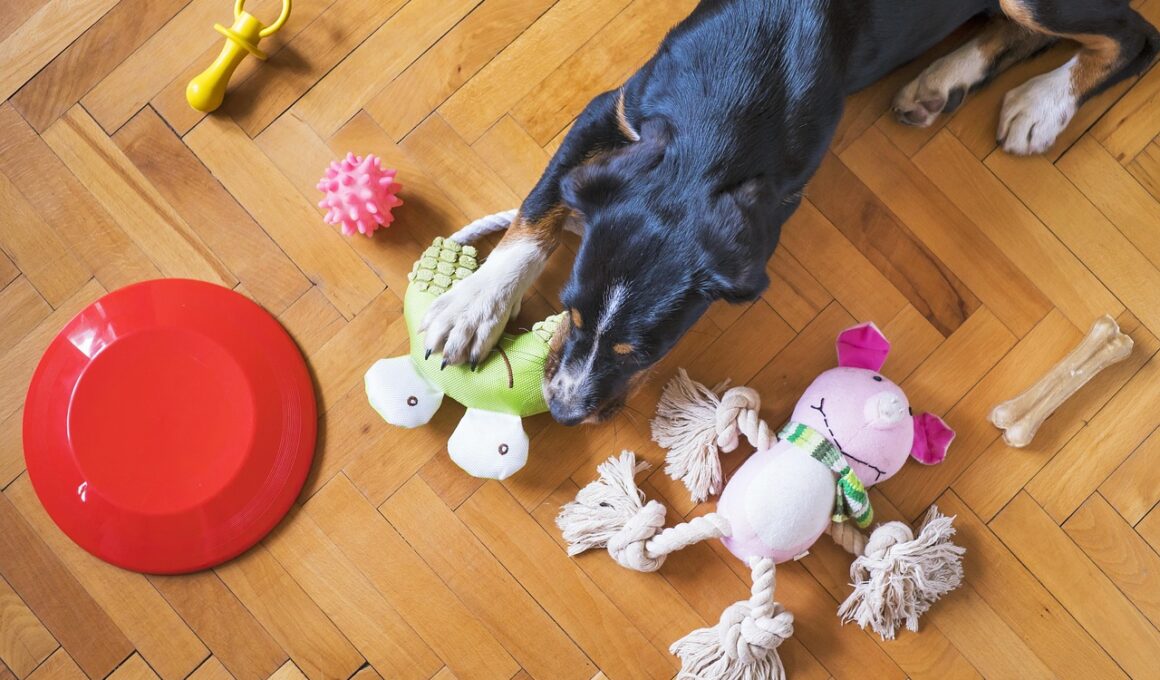Safe Toy Choices to Prevent Choking and Injury at Home
Ensuring your dog’s safety at home begins with selecting the right toys. The vast selection of pet toys can be overwhelming, but prioritizing safety is essential. Always choose durable toys made from non-toxic materials to reduce hazards. Look for those that are specifically designed for your dog’s size and chewing habits. For instance, toys that are too small pose a choking risk, while those that are too large can be difficult to handle. Assess your dog’s play style: does your dog chew aggressively or play lightly? Understanding their behavior can inform better choices, ensuring playtime is fun and safe. Consider options such as rubber toys or plush toys made from safe materials. It’s also prudent to check for small parts that can detach and become choking hazards. Keep an eye out for the dog toy’s age recommendations, indicating how long it should last under typical conditions. By making informed choices and regularly inspecting toys for wear or damage, you contribute greatly to your pet’s health and safety. Moreover, engaging with a veterinarian can provide tailored advice based on your dog’s specific needs and preferences, ensuring comprehensive safety at home.
Alongside selecting appropriate toys, creating a safe environment for your dog is crucial. When introducing a new toy, monitor your dog to assess their interaction. Books, websites, and pet stores often provide information on best practices in dog safety, including recommendations for toys. It is important to remove toys that seem damaged or too worn. Even well-made toys can deteriorate over time. Take note of components that can break off and pose choking risks. For instance, squeakers in toys can become a hazard if dislodged. Additionally, rotating toys regularly prevents boredom while ensuring that they remain safe and engaging for your dog. Store toys safely and create a designated area for playtime to prevent accidents. Clear away any small items in the vicinity, as these can be misconstrued as toys by your curious dog. Always supervise your dog, especially if they’re known to chew vigorously. If you notice any unusual behavior like excessive drooling or difficulty swallowing, seek immediate veterinary attention. By following these guidelines, you create a secure playground for your dog so that fun stays in the forefront while risks are minimized.
Understanding Toy Materials and Safety Standards
Understanding the materials used in dog toys is fundamental to ensuring your furry friend’s safety. Look for toys made from durable, non-toxic materials such as rubber or safe, breathable fabrics. Avoid items that contain harmful chemicals or materials that can break apart easily. Pet toy manufacturers often provide safety certifications and guidelines that can assist you in making well-informed choices. Familiarize yourself with terms like BPA-free, lead-free, and phthalates-free, as these indicate safer products for consumption. Regularly check for any recalls on pet products, as this information can help identify harmful toys in your home. Additionally, the toy size should match your dog’s breed and chewing strength to prevent choking. Engaging your pet in interactive play with safe toys helps regulate energy levels, relieve stress, and stimulate their minds. Look for products labeled as suitable for aggressive chewers if your dog falls into that category. The best toys not only entertain but also promote dental health and mental well-being. Stay informed about industry standards as they evolve, so you always choose the latest and safest options for your beloved companion.
Regularly engaging with your dog using safe toys promotes a trusting relationship. Interactive toys contribute positively to your dog’s mental and physical health, allowing for bond strengthening. Opt for puzzle toys or treat-dispensing ones that challenge your dog while keeping them entertained. Similarly, toys that provoke problem-solving can help divert their attention from less acceptable items in your home. Ensure that playtime is structured; inconsistent play can lead to frustration or overwhelm. Understanding your dog’s unique preferences will guide your toy selection. Always incorporate breaks during playtime to maintain a relaxed atmosphere. A balanced approach that mixes energetic play with calm periods will ensure sustained joy. Additionally, training your dog to understand what toys are permissible versus household items is essential. Use positive reinforcement to encourage your dog to engage with safe toys, while redirecting them gently when necessary. Teaching them about boundaries keeps your home safe and avoids dangerous situations. Customizing the play experience based on the dog’s age and interests keeps everything enjoyable. Adopting these practices establishes a predictable routine that your dog can rely on, contributing further to their emotional stability and happiness.
Identifying Risks and Responding
Recognizing risks associated with dog toys is pivotal in ensuring a safe environment. It’s crucial to know your dog’s play behavior and to be vigilant during playtime. When your dog plays, examine the toy closely. Look for any signs of damage, wear, or ingested materials. Toys may be soft but can still hide certain dangers, particularly if they disintegrate upon chewing. When you detect pieces of a toy that could cause choking, promptly discard it, avoiding any temptation for repair. Additionally, some dogs are resourceful and may find ways to access hidden dangers, such as other toys or household items that could be harmful. Monitor their behavior closely, especially during playdates. Encourage safe play methods to prevent any undesirable incident. Teaching your dog the command ‘leave it’ can be invaluable when they encounter unsafe items. Understanding how to respond swiftly to choking incidents is equally important; educate yourself on emergency procedures. Seek training classes that cover safety protocols, enhancing both your preparedness and your dog’s experience. Safety is a partnership, and vigilance is key to protecting your dog from potential hazards around the home.
Maintaining your dog’s toys is vital for their longevity and safety. Regular cleaning routines should be established to remove dirt, bacteria, and other contaminants. Use pet-safe cleaning solutions or a simple mixture of soap and water, ensuring that all residues are completely rinsed. For toys that are machine washable, include them in your routine washes every couple of weeks. Drying them thoroughly afterward is essential to prevent mold or mildew. Always check manufacturer instructions for specific care guidelines, as some materials are sensitive to heat or chemicals. Consider dedicating a specific basket or container for storing toys, keeping them organized while ensuring safety. A clean environment contributes to your dog’s overall health and happiness. Also, consider toys that are easy to clean, as this will encourage regular upkeep and prolong their usage. Having a rotation system allows your dog to experience different toys, keeping playtime fresh and engaging. Ensure that toys are safe for ingestion, as natural materials may decompose or splinter. By actively maintaining your dog’s playthings, you provide them a safer experience, reducing risks while encouraging enjoyment and healthy habits.
Conclusion: A Commitment to Safety
Creating a safe environment for your dog at home requires commitment and continuous awareness. From toy selection to routine maintenance, every little detail counts. Establish boundaries that help your dog understand acceptable play objects. When in doubt, consult pet safety resources, such as veterinarians or reputable websites. Engage your dog with safe toys and techniques that nurture their exploration and natural instincts without compromising their well-being. Encourage interaction and monitor progress, using every opportunity to enhance bonding and communication. Developing a playtime routine helps solidify your dog’s understanding of safe toys versus other items. Share experiences with fellow dog owners to learn about different approaches and toy choices, continuously seeking insights into improving safety standards. As you prioritize dog safety at home, you establish a mindset where both you and your pet thrive in a secure atmosphere. Your commitment ensures that home remains a sanctuary filled with joy, companionship, and well-being for your furry friend. By making informed decisions, you create a nurturing space that contributes to your dog’s lifelong happiness, while leading to a healthier relationship overall.
This insightful journey leads to a world where dog safety is paramount and the right choices make all the difference. As a responsible dog owner, investing time in understanding, selecting and maintaining safe toys culminates in a rewarding experience. By fostering a closer bond, you encourage genuine happiness and trust between yourself and your furry companion. The more aware you are of potential hazards, the better you can prevent them. Be proactive — stay updated with safety standards and guidelines, transforming your home into a haven where joy prevails. Create an enriching environment where your dog feels secure and fulfilled, thereby alleviating common behavioral issues. Recognizing your role in ensuring safety reinforces the love and companionship you share. Always prioritize your pet’s needs first, and enjoy the fun and playful interactions that safe toys facilitate. A dog sustainably enjoying a wide range of approved toys will lead to healthy development and an energetic spirit. Thus, dedicating time to learning about dog safety is certainly worthwhile. Make safety a part of your routine, and enjoy many years of laughter, love, and cherished memories with your four-legged family member.


